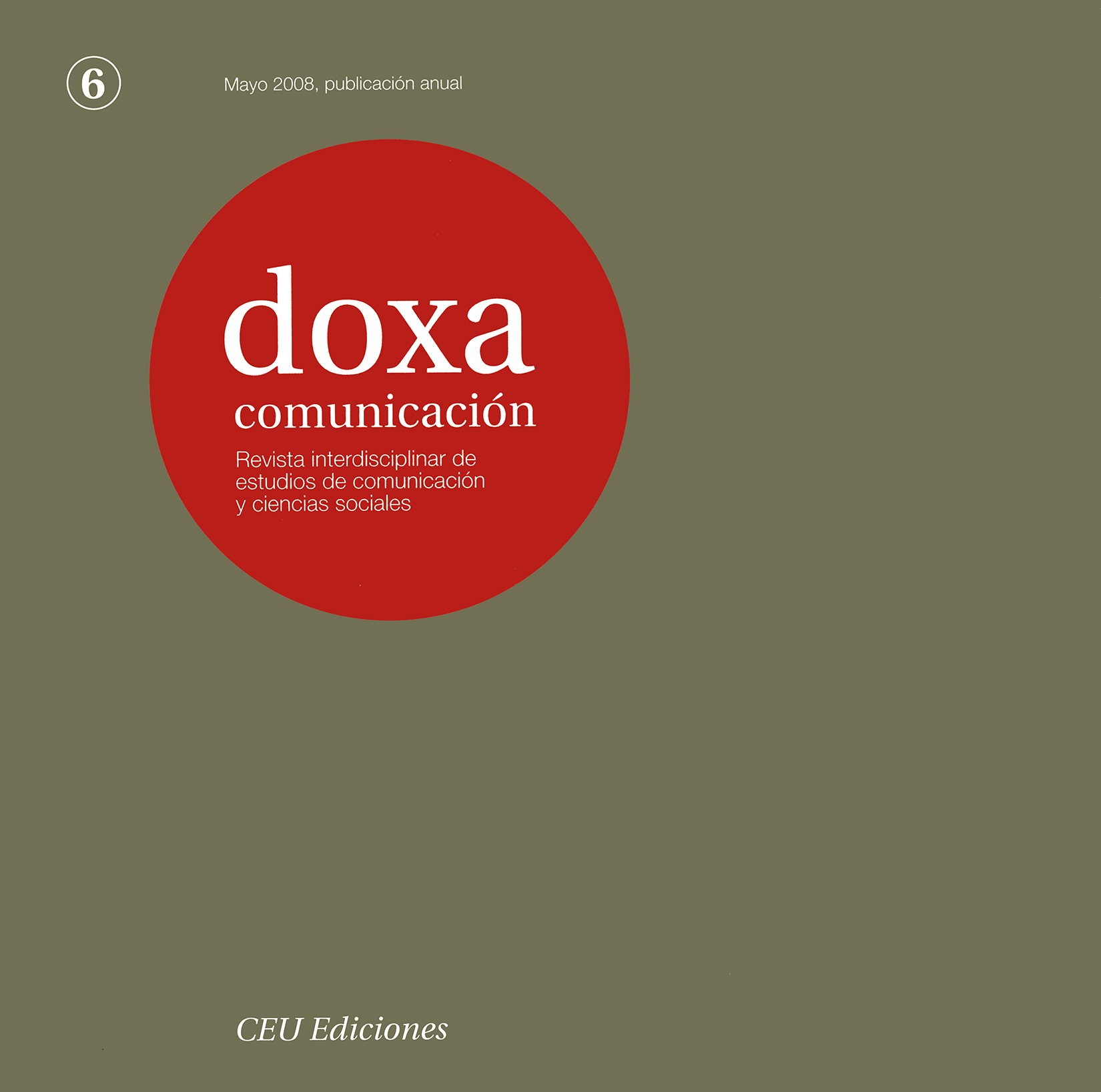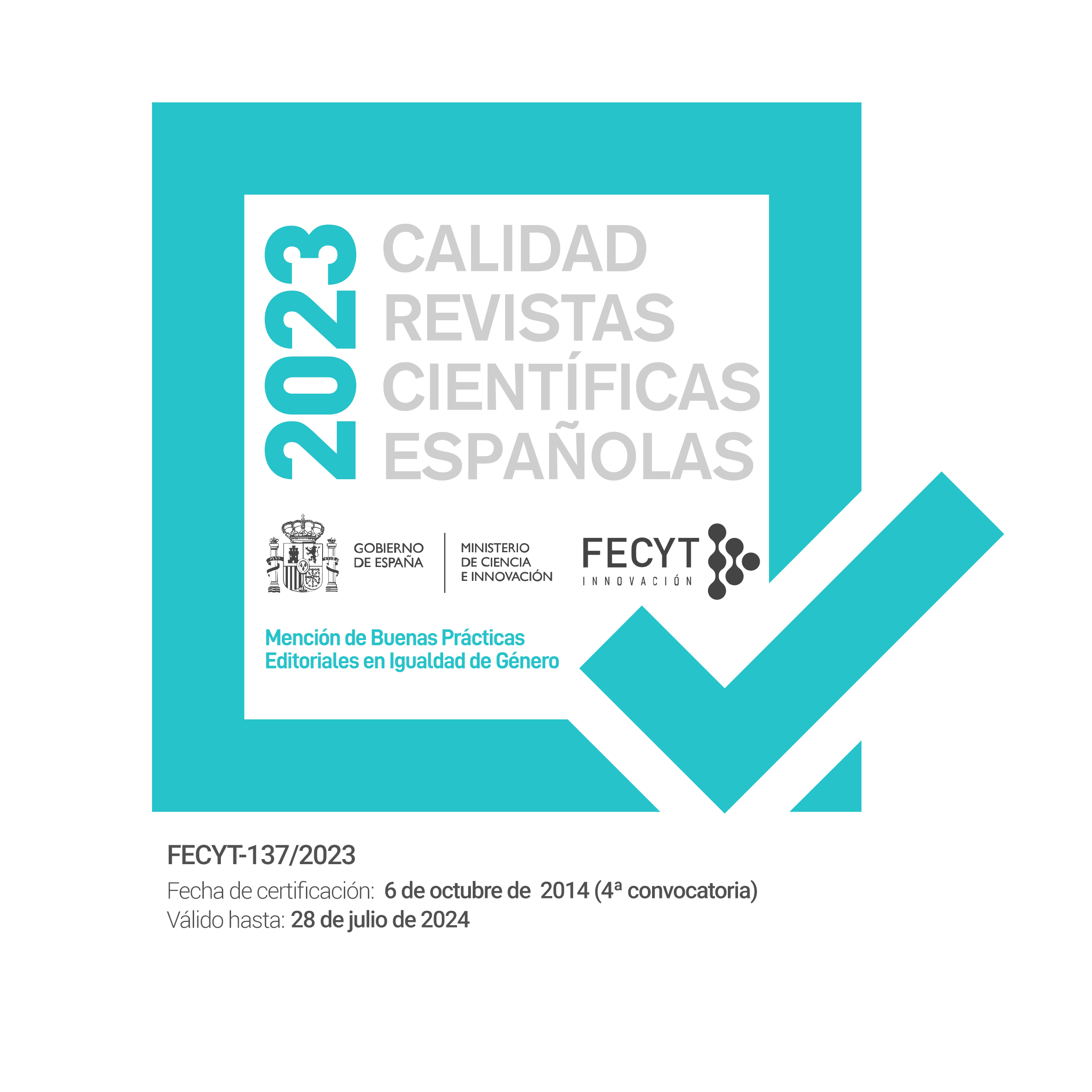La infancia construida: efectos prosociales y antisociales de los contenidos televisivos
DOI:
https://doi.org/10.31921/doxacom.n6a7Palabras clave:
Televisión, niños, meta-análisis, efectos prosociales, violenciaResumen
El objetivo del presente artículo es presentar la evidencia actual sobre los efectos prosociales y antisociales de la televisión en la infancia. Se realiza una revisión exhaustiva acerca de las últimas revisiones de meta-análisis. Los resultados son concluyentes: el impacto de los contenidos televisivos de carácter violento puede llegar a explicar casi un 10% de la conducta agresiva y los contenidos prosociales un 5% de las conductas del mismo signo. Por tanto, son necesarios mecanismos de autorregulación de los contenidos audiovisuales y también se precisan estudios de análisis de contenido independientes para la evaluación de los contenidos televisivos.
Descargas
Citas
Abelman, R. y Atkin, D. (2000): “What children watch when they watch TV: putting theory into practice”, Journal of Broadcasting and Electronic Media, vol. 44, pp. 143-154.
Anderson, C.A. (2004): “An update on the effects of playing violent video games”, Journal of Adolescence, vol. 27, pp. 113–122.
Anderson, C.A. y Bushmann, B.J. (2002): “The effects of media violence on society”, Science, vol. 295, pp. 2377-2379.
Bandura, A. (1996): “Teoría social cognitiva de la comunicación de masas”, en Bryant, J. y Zill- mann, D. (comps.): Los efectos de los medios de comunicación. Investigaciones y teorías. Barcelona: Paidós, pp. 88-126.
Bandura, A. (2002): “Social cognitive theory of mass Communications”, en Bryant, J. y Zill- mann, D. (eds.): Media effects. Advances in theory and research. Mahwah, NJ: Lawrence Erlbaum Associates, pp. 121-154.
Bryant, J. y Miron, D. (2002): “Entertainment as media effect”, en Bryant, J. y Zillmann, D. (eds.): Media effects. Advances in theory and research. Mahwah, NJ: Lawrence Erlbaum Associates, pp. 549-582.
Bryant, J. y Thompson, S. (2002): Fundamentals of media effects, Nueva York: McGraw-Hill.
Bryant, J. y Zillmann, D. (1986): Perspectives on media effects, Hillsdale, NJ: Lawrence Erlbaum Associates.
Bryant, J. y Zillmann, D. (1996): Los efectos de los medios de comunicación. Investigaciones y teorías, Barcelona: Paidós.
Bryant, J. y Zillmann, D. (2002): Media effects. Advances in theory and research, Mahwah, NJ: Lawrence Erlbaum Associates.
Bushmann, B.J. y Anderson, C.A. (2001): “Media violence and the American public. Scientific facts versus media misinformation”, American Psychologist, vol. 56, pp. 477-489.
Cohen, J. (1988): Statistical power analysis for the behavioral sciences, Hillsdale, NJ: Lawrence Erlbaum Associates (2a edición).
Condry, J. (1989): The psychology of television, Hillsdale, NJ: Lawrence Erlbaum Associates.
Comstock, G. (2004): “Paths from television violence to aggression: reinterpreting the evidence”, en Shrum, L.J. (ed.): The psychology of entertainment media. Blurring the lines between entertainment and persuasion. Mahwah, NJ: Lawrence Erlbaum Associates, pp. 193-211.
Del Río, P. (1996): Psicología de los medios de comunicación, Madrid: Síntesis.
Federman, J. (1998): National television violence study. Volume 3. Executive summary, Santa Barbara, CA: Center for Communication and Social Policy, University of California.
Fish, S.M. y Truglio, R.T. (2001): “G” is for growing. Thirty years of research on children and “Sesame Street”, Mahwah, NJ: Lawrence Erlbaum Associates.
Garitaonandia, C., Juaristi, O. y Oleaga, J.A. (2001): “Media genres and content preferences”, en Livingstone, S. y Bovill, M. (eds.): Children and their changing media environment. A European comparative study. Mahwah, NJ: Lawrence Erlbaum Associates, pp. 141-158.
Gerbner, G. y Gross, L. (1976): “Living with television: the violence profile”, Journal of Communication, vol. 26, pp. 173-199.
Gerbner, G., Gross, L., Morgan, M. y Signorielli, N. (1990): “Trazando la corriente dominante: contribuciones de la televisión a las orientaciones políticas”, Revista de Psicología Social, vol. 5, pp. 71-79.
Gerbner, G., Gross, L., Morgan, M. y Signorielli, N. (1996): “Crecer con la televisión: perspectiva de aculturación”, en Bryant, J. y Zillmann, D. (comps.): Los efectos de los medios de comu- nicación. Investigaciones y teorías. Barcelona: Paidós, pp. 35-66.
Gerbner, G., Gross, L., Morgan, M., Signorielli, N. y Shanahan, J. (2002): “Growing up with television: cultivation processes”, en Bryant, J. y Zillmann, D. (comps.): Media effects. Advances in theory and research. Mahwah, NJ: Lawrence Erlbaum Associates, pp. 43-68.
Giles, D. (2003): Media psychology, Mahwah, NJ: Lawrence Erlbaum Associates.
Glass, G.V (1978): “Integrating findings. The meta-analysis of research”, Review of Research in Education, vol. 5, pp. 351-379.
Greenberg, B.S. (1974): “Gratifications of television viewing and their correlates for British children”, en Blumer, J.G. y Katz, E. (comps.): The uses of mass communications. Current perspectives on gratification research. Beverly Hills, CA: Sage, pp. 71-92.
Greenberg, B.S., Atkin, C.K., Edison, N.G. y Korzenny, F. (1980): “Antisocial and prosocial behaviors on television”, en Greenberg, B.S. (ed.): Life on television. Content analysis of U.S. TV drama. Norwood, NJ: Ablex, pp. 99-128.
Gunter, B. (1996): “Acerca de la violencia de los media”, en Bryant, J. y Zillmann, D. (comps.): Los efectos de los medios de comunicación. Investigaciones y teorías. Barcelona: Paidós, pp. 223- 286.
Hearold, S. (1986): “A sintesis of 1043 effects of television on social behaviour”, en Comstock, G. (ed.): Public Communications and behaviour. Nueva York: Academic Press, vol. 1, pp. 65-133.
Huesmann, L.R., Moise-Titus, J., Podolski, C.L. y Eron, L.D. (2003): “Longitudinal relations bet- ween children’s exposure to TV violence and their aggressive and violent behavior in young adulthood: 1977-1992”, Developmental Psychology, vol. 39, pp. 201-221.
Igartua, J.J. (2002): “El análisis del sistema de mensajes: hacia una definición de la violencia desde el proyecto de Indicadores Culturales”, en Cultura y Educación, vol. 14, pp. 43-54.
Igartua, J.J. (2005): “Efectos psicosociales de la comunicación”, en Moral, F. y Igartua, J. J. (eds.): Psicología social de la comunicación. Aspectos teóricos y prácticos. Málaga: Aljibe, pp. 125-144.
Igartua, J.J. (2006): Métodos cuantitativos de investigación en comunicación, Barcelona: Bosch.
Igartua, J.J. (2007): Persuasión narrativa, Alicante: Editorial Club Universitario.
Igartua, J.J., Cheng, L., Corral, E., Martín, J., Simón, J., Ballesteros, R. y de la Torre, A. (2001): “Violencia en la ficción televisiva. Hacia la construcción de un índice de violencia desde el análisis agregado de la programación”, Zer. Revista de Estudios de Comunicación, vol. 10, pp. 59-79.
Igartua, J.J. y Humanes, M.L. (2004): Teoría e investigación en comunicación social, Madrid: Síntesis.
Igartua, J.J., Muñiz, C., Elena, N. y Elena, A. (2003): “El consumo televisivo desde la perspectiva de los usos y gratificaciones”, en Igartua, J.J. y Badillo, A. (eds.): Audiencias y medios de comunicación. Salamanca: Ediciones Universidad de Salamanca, pp. 147-160.
Liebert, R.M. y Paulos, R.W. (1975): “Television and personality development: the socializing effects o fan Entertainment medium”, en Davids, A. (ed.): Child personality and psychopathology. Current perspectives. Nueva York: Wiley, vol. 2, pp. 61-97.
Lipsey, M.W. (1990): Design sensitivity. Statistical power for experimental research, Newbury Park, CA: Sage.
Liss, M.B. y Reinhart, L.C. (1980): “Aggression on prosocial televisión programs”, Psychological Reports, vol. 46, pp. 1065-1066.
Mares, M.L., Palmer, E. y Sullivan, T. (en prensa): “Prosocial effects of media exposure”. En Cal- vert, S. y Wilson, B.J. (eds.): The Blackwell handbook of children, media and development. Malden, MA: Blackwell.
Mares, M.L. y Woodard, E. (2005): “Positive effects of television on children’s social interactions: a meta-analysis”, Media Psychology, vol. 7, pp. 301-322.
Mares, M.L. y Woodard, E. (2007): “Positive effects of television on children’s social interactions: a meta-analysis”, en Preiss, R.W., Gayle, B.M., Burrell, N., Allen, M. y Bryant, J. (eds.): Mass media effects research. Advances through meta-analysis. Mahwah, NJ: Lawrence Erlbaum Associates, pp. 281-300.
Nathanson, A.I. y Cantor, J. (2000): “Reducing the aggression-promoting effect of violent cartoons by increasing children’s fictional involvement with the victim: a study of active mediation”, Journal of Broadcasting and Electronic Media, vol. 44, pp. 125-142.
Nikken, P. (2003): “Twelve years of Dutch children’s television: efforts of public and commercial TV channels for children up to twelve years old”, Communications. The European Journal of Communication Research, vol. 28, pp. 33-52.
NTVS (1997): National television violence study. Volume 1, Thousand Oacks, CA: Sage. NTVS (1998): National television violence study. Volume 3, Thousand Oaks, CA: Sage.
Neuendorf, K.A. (2002): The content analysis guidebook, Thousand Oaks, CA: Sage.
Páez, D. (2003): “El objeto de estudio de la Psicología Social”, en Páez, D., Fernández, I. Ubillos, S. y Zubieta, E. (coords.): Psicología Social, cultura y educación. Madrid: Pearson-Prentice Hall, pp. 3-23.
Paik, H. y Comstock, G. (1994): “The effects of television violence on antisocial behaviour: A meta-analysis”, Communication Research, vol. 21, pp. 516-546.
Pérez-Ornia, J.R. y Nuñez Ladevéze, L. (2006): “Lo que los niños ven en la televisión”, Zer. Revista de Estudios de Comunicación, vol. 20, pp. 133-177.
Perse, E.M. (2001): Media effects and society, Mahwah, NJ: Lawrence Erlbaum Associates.
Perse, E. (2007): “Meta-analysis: demostrating the power of mass communications”, en Preiss, R.W., Gayle, B. M., Burrell, N., Allen, M. y Bryant, J. (eds.): Mass media effects research. Advances through meta-analysis. Mahwah, NJ: Lawrence Erlbaum Associates, pp. 467-488.
Perry, D.K. (2002): Theory and research in mass communication. Contexts and consequences, Mahwah, NJ: Lawrence Erlbaum Associates.
Pfau, M. (2007): “What’s in a meta-analysis”, en Preiss, R.W., Gayle, B.M., Burrell, N., Allen, M. y Bryant, J. (eds.): Mass media effects research. Advances through meta-analysis. Mahwah, NJ: Lawrence Erlbaum Associates, pp. 455-465.
Rayburn, J.D. (1996): “Uses and gratifications”, en Salwen, M.B. y Stacks, D.W. (eds.): An integrated approach to communication theory and research. Mahwah, NJ: Lawrence Erlbaum Associates, pp. 145-163.
Rideout, V.J., Vandewater, E.A. y Wartella, E.A. (2003): Zero to six. Electronic media in the lives of infants, toddlers and preschoolers, Menlo Park, CA: The Henry J. Kaiser Family Foundation. Disponible en: http://www.kff.org/.
Rosenthal, R. (1986): “Media violence, antisocial behavior and the social consequences of small effects”, Journal of Social Issues, vol. 42, pp. 141-154.
Rosenthal, R. y Rubin, D.B. (1982): “A simple, general purpose display of magnitude of experimental effect”, Journal of Educational Psychology, vol. 74, pp. 166-169.
Rubin, A.M. (1996): “Usos y efectos de los media: una perspectiva uso-gratificación”, en Bryant, J. y Zillmann, D. (comps.): Los efectos de los medios de comunicación. Investigaciones y teorías. Barcelona: Paidós, pp. 555-582.
Rubin, A.M. (2002): “The uses-and-gratifications perspective of media effects”, en Bryant, J. y Zillmann, D. (eds.): Media effects. Advances in tehory and research. Mahwah, NJ: Lawrence Erl- baum Associates, pp. 525-548.
Shanahan, J. y Morgan, M. (1999): Television and its viewers. Cultivation theory and research, Cambridge: Cambridge University Press.
Shrum, L.J. (2002): “Media consumption and perceptions of social reality: effects and underlying processes”, en Bryant, J. y Zillmann, D. (comps.): Media effects. Advances in theory and research. Mahwah, NJ: Lawrence Erlbaum Associates, pp. 69-96.
Signorielli, N. y Morgan, M. (1996): “Cultivation analysis: research and practice”, en Salwen, M.B. y Stacks, D.W. (eds.): An integrated approach to communication theory and research. Mahwah, NJ: Lawrence Erlbaum Associates, pp. 111-126.
Sparks, G.G. (2002): Media effects research. A basic overview, Belmont, CA: Wadsworth/Thompson Learning.
Sparks, G.G. y Sparks, C.W. (2002): “Effects of media violence”, en Bryant, J. y Zillmann, D. (eds.): Media effects. Advances in theory and research. Mahwah, NJ: Lawrence Erlbaum Asso- ciates, pp. 269-285.
Valkenburg, P.M., Kcmar, M., Peeters, A.L. y Marseille, N.M. (1999): “Developing a scale to assess three styles of television mediation: instructive mediation, restrictive mediation and social coviewing”, Journal of Broadcasting and Electronic Media, vol. 43, pp. 52-66.
Vandewater, E.A., Bickham, D.S., Lee, J.H., Cummings, H.M., Wartella, E.A. y Rideout, V.J. (2005): “When the television is always on. Heavy television exposure and young children’s de- velopment”, American Behavioral Scientist, vol. 48, pp. 562-577.
Webster, J.G. (1998): “The audience”, Journal of Broadcasting and Electronic Media, vol. 42, pp. 190-207.
Wilson, B.J., Smith, S.L., Potter, W.J., Kunkel, D., Linz, D., Colvin, C.M. y Donnerstein, E. (2002): “Violence in children’s television programming: assessing the risks”, Journal of Communication, vol. 52, pp. 5-35.
Woodard, E.H. (1999): The 1999 state of children’s television report. Programming for children over broadcast and cable television (report no 28), Philadelphia: Annenberg Public Police Center of the University of Pennsylvannia. Disponible en: http://www.annenbergpublicpolicycenter.org.
Descargas
Publicado
Cómo citar
Número
Sección
Licencia
Derechos de autor 2008 http://creativecommons.org/licenses/by-nc/4.0

Esta obra está bajo una licencia internacional Creative Commons Atribución-NoComercial 4.0.



























